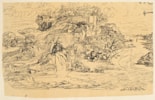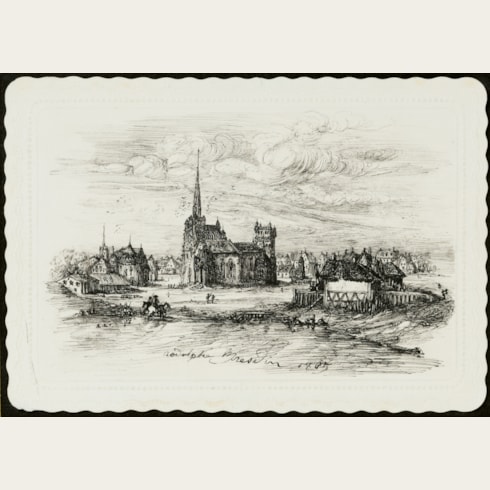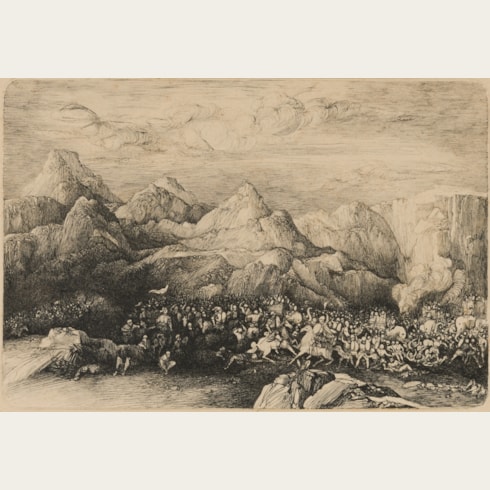Rodolphe BRESDIN
(Montrelais 1822 - Sèvres 1885)
Landscape with Fishermen
Sold
Pen and black ink on papier calque, laid down.
Signed and dated 1858 Rodolphe Bresdin at the lower right.
107 x 172 mm. (4 1/4 x 6 3/4 in.) at greatest dimensions.
Signed and dated 1858 Rodolphe Bresdin at the lower right.
107 x 172 mm. (4 1/4 x 6 3/4 in.) at greatest dimensions.
In common with most of Rodolphe Bresdin’s drawings, this drawing is drawn with a very fine pen in black ink (also known as India ink, or encre de Chine) on tracing paper. The majority of Bresdin’s drawings are, in fact, on such transparent tracing paper (in French, papier calque), with the translucency of the paper helping to transfer or reverse designs and motifs to a print medium. Bresdin also made extensive use of papier calque to copy illustrations from books or magazines, a practice he adopted as early as the late 184’s or early 1850s, and which provided him with a rich and varied source of motifs to use in his own work.
The present sheet is dated 1858, when the artist was living in Toulouse and producing some of the most imaginative and exceptional works of his career. Depictions of fishermen occur occasionally among Bresdin’s drawings and etchings; a comparable small drawing of anglers appeared at auction in Paris in 2014. (The artist himself is known to have fished on the banks of the Garonne river, which runs through the city of Toulouse.) Among other stylistically comparable pen and ink drawings is a Landscape with Smugglers, likewise dated 1858, in the collection of the Art Institute of Chicago.
The present sheet is dated 1858, when the artist was living in Toulouse and producing some of the most imaginative and exceptional works of his career. Depictions of fishermen occur occasionally among Bresdin’s drawings and etchings; a comparable small drawing of anglers appeared at auction in Paris in 2014. (The artist himself is known to have fished on the banks of the Garonne river, which runs through the city of Toulouse.) Among other stylistically comparable pen and ink drawings is a Landscape with Smugglers, likewise dated 1858, in the collection of the Art Institute of Chicago.
A draughtsman and printmaker, Rodolphe Bresdin seems to have been entirely self-taught. His early career was spent in Paris, where he worked as an etcher. An eccentric, somewhat bohemian figure, he served as the inspiration for the impoverished artist-hero of Champfleury’s novel Chien-caillou, published in 1845; indeed, for most of his career Bresdin was also known by the nickname ‘Chien-Caillou’. He left Paris in 1849 for the town of Corrèze and by 1852 had settled in Toulouse, where he worked for several years. Despite living in abject poverty, this was a period of considerable productivity for the artist, who received several commissions and began to produce his first mature prints.
Although Bresdin exhibited in several Salons between 1848 and 1879, he failed to achieve much recognition or financial success. For most of the 1860’s he lived and worked in Bordeaux, where he briefly taught the young Odilon Redon, who was to become a devoted friend and champion. Bresdin emigrated to Canada in 1873 but struggled to make a living there and returned to France four years later, eventually working as a street-sweeper. In 1880, destitute and in ill-health, he abandoned his family and the following year moved into a garret in Sèvres, where he was found dead one day in January 1885. Although greatly admired by such writers as Champfleury, Baudelaire, Huysmans and Montesquieu, Bresdin’s work was first brought to public notice and acclaim at a retrospective exhibition held at the Salon d’Automne in 1908.
As no paintings by the artist have survived, Bresdin’s entire oeuvre consists of drawings, etchings and lithographs. While his graphic work is well-known today, Bresdin’s activity as a draughtsman is equally vital to an understanding of his art. Like his prints, his drawings were never on a very large scale, yet were always intricately drawn and minutely detailed.
Many of Bresdin’s drawings are finished works in pen and ink, and were created as independent works of art for exhibition or sale. However, from a career spanning some fifty years, only slightly more than four hundred drawings by Bresdin survive today, alongside a graphic oeuvre of around 160 prints. Only rarely do his drawings appear on the market, and they remain particularly scarce outside important groups of sheets in several public collections, notably the Bibliothèque Nationale in Paris, the Gemeentemuseum in The Hague and the Art Institute of Chicago; each based on collections formed by particular friends of the artist, to whom he presented his drawings.
Provenance
In the artist’s studio at the time of his death
The artist’s daughter, Julie Rodolphine Bresdin
By descent in the family of the artist.
The artist’s daughter, Julie Rodolphine Bresdin
By descent in the family of the artist.






